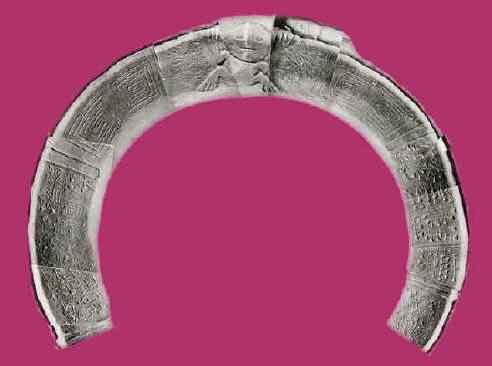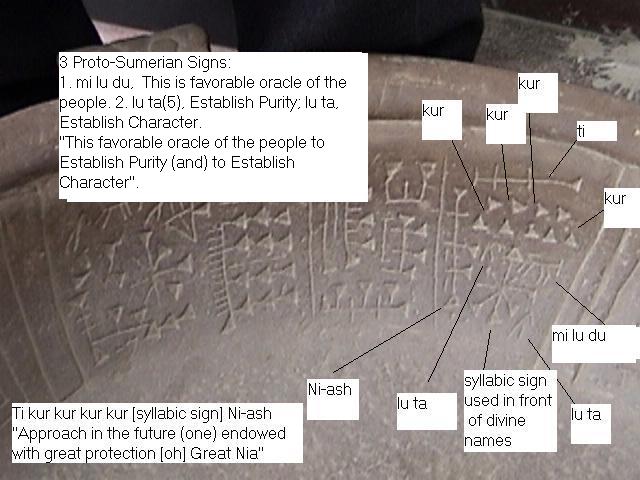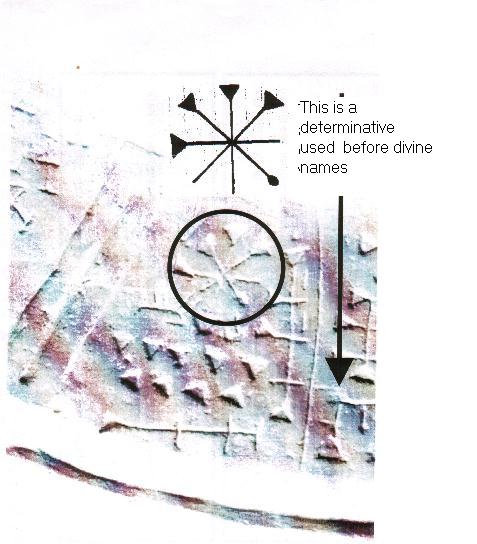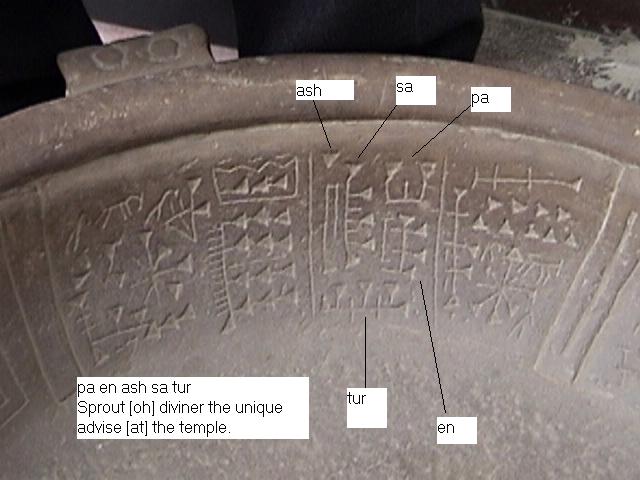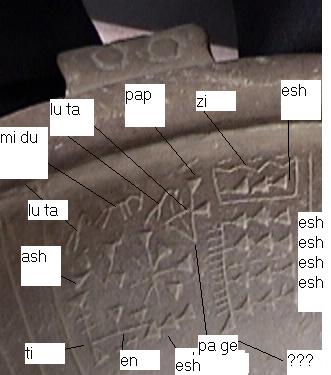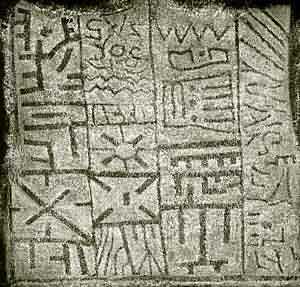|
Bolivian Sumerian Connection |
||||||||||
|
The Fuente Magna, found on the property of the Manjon family by a local peasant, is a large stone vessel, resembling a libation bowl. The property is located in the area surrounding Lake Titicaca about 75/80 km from the city of La Paz. While the section of the rim has an
uncanny resemblance
to the Star Gates we are studying, what is important
and of archeological
significance, is the cuneiform
writing
on one section of the rim. The two snakes bordering
the rim facing the
central figure is also noteworthy.
Source
|
||||||||||
|
Excerpt
In 1958/60 Don Max Portugal Zamora, a Bolivian archaeologist, learned of it's existence Pastor Manjon. Mr. Portugal "baptized" the site with the name it bears today, "Fuente Magna"--in our view an accurate assessment. Instantly it's rescuing was studiously embarked upon. Through the mediation and negotiation of General Armando Escobar Uria property was swapped for another parcel in the neighborhood of Sopocachi. Safely under the protection of the honorable, municipal, mayoralty Mr. Portugal began to restore it by applying cement to the parts that showed chipping and deterioration minor repairs for effect, in our view. He lost no time in attempting to decipher the writing inside the object turning to the texts known as "Qellga Llippichi" one of those interpreted by Don Franz Tamayo. He also consulted a publication by our illustrious friend, Dr. Dick Edgar Ibarra Grasso, entitled "Indigenous Andean Writing" (HAM La Paz 1953), it ends as you might expect (fruitless). The limits of his honest efforts. The writing is undoubted from the Old World. Hebraic from the sinaitic
appearance influenced by cuneiform, or
simply cuneiform of possible Sumero-Akkadian
origins, this being the take-off
point on which we announced our extraordinary
discovery. Two mayors (local
guys) don Armando Escobar Uria and Don Mario Mercado
Vaca Guzman have been
looking after our investigation until very recently
with many restrictions
since we cannot count on the support of the
state.
1. We are dealing with an object which was made
in keeping with Mesopotamian
tradition.
|
||||||||||
|
By Clyde A. Winters
Below is a decipherment of the cuneiform writing on the Fuente Bowl Cuneiform Writing on the Fuente Bowl To translate the cuneiform I used Samuel A. B. Mercer's, Assyrian grammar with chrestomuthy and glossary (N.Y.:AMS Press,1966) to compare the signs found on the Fuente bowl with the cuneiform syllabary. To read the Sumerian text I used John L. Hayes, A Manuel of Sumerian: Grammar and text ( Malibu,CA:Udena Publications, 2000) and John A Halloran, Sumerian Lexicon, http://www.sumerian.org/sumerlex.htm I will translate the Sumerian cuneiform in panels 1 and 2 of the cuneiform text reading from right to left. In the first panel there is no mention of
Shamash the sun god. This
is the Akkadian word for the sun god, the name of
the sun god in Sumerian
was Utu. Reading the text from right to left top to
bottom we find the
following;
Ti Kur kur kur kur (determinative for divine names) Nia (lit. ni-ash) (Figure 1) Translation: "Approach in the future (one) endowed with great protection the great Nia". "This favorable oracle of the people to establish purity and to establish character [for all who seek it]". This first panel is very interesting. There are
three Proto-Sumerian
signs in this panel. Here we also find the use of
the divine determinative.
Hayes, page 35 (figure 5a) discusses this sign.
I have interpreted the sign Ni-ash as Nia, because of the fact that when a syllable is joined to a consonant vowel form the adjoining sign becomes a single vowel. If we read the signs as Ni-ash it means: "unique awe". The Sumerian goddess was Nammu, we know very little about this goddess because much of the knowledge about her was lost at the beginning of Ur111. According to Hayes she was recognized as "the mother who gave birth to heaven and earth", the primeval mother, who gave birth to the gods" (Hayes, p.35). This passage suggests that the original name for Nammu was Nia. The quote from Hayes makes it clear that Nammu-Nia was highly regarded and was worshipped as the main god before the rise of any other Sumerian gods. In the second panel reading from right to left,
top to the bottom
we find the following:
Transliteration Panel 2: Pa en ash sa tur Translation: "Sprout [oh] diviner the unique advise [at] the temple" This translation of the first two panels of the cuneiform writing reads as follows: "Approach in the future (one) endowed with great protection the Great Nia". "[The Divine One Nia(sh) to] Establish Purity, Establish Gladness, Establish Character" "[Use this talisman (the Fuente bowl)] To sprout [oh] diviner the unique advise [at] the temple". Here we have panel 3, of the Fuente bowl. The
signs on this panel
are very interesting, as in the other panels we see
a combination of Proto-Sumerian
and cuneiform signs.
Panel 3 Reading from right to left, top to bottom. We have the following: Zi esh The righteous shrine Esh esh esh esh Anoint the shrine, anoint the shrine Pap pa ge The leader takes an oath [to] Lu ta mi du lu ta Establish Purity , a favorable oracle (and) Establish character Bar nu ash Open up a unique light [i.e., knowledge, for all] Ash ti en Wish for a noble life The entire panel reads as follows: "The righteous shrine, anoint (this) shrine, anoint (this) shrine; The leader takes an oath [to] Establish purity, a favorable oracle (and to) Establish character. [Oh leader of the cult] Open up a unique light [for all], [who] wish for a noble life". Commentary The cuneiform writing was interesting for two reasons. First, we find that these panels have proto-Sumerian symbols mixed with the cuneiform symbols.Secondly, whereas, the wedges of most Sumerian cuneiform text point leftward, the wedges of the Fuente cuneiform signs point rightward. This may result from the fact that in the Fuente text , the letters are read from right to left, instead of left to right like the cuneiform text from Mesopotamia.The passage on the cuneiform panels of the Fuente Bowl seems to be very similar to the Proto-Sumerian inscription on the right side of the bowl. This translation makes it clear that the passage complements my earlier decipherment of the Proto-Sumerian text also found on the left side of the Fuente Bowl. SOURCE
- Article and Translation by Dr.
Clyde
A. Winters
|
||||||||||
|
|
||||||||||
|
The Pokotia monolith was
discovered by Bernardo Biados, Freddy Arce,
Javier Escalente, Cesar Calisaya, Leocadio Ticlla,
Alberto Vasquez, Alvaro
Fernholz, Omar Sadud, Paulo Batuani and Rodrigo
Velasco on January 4, 2002.
This discovery and other research done by these
scientist is supported
by the Honorable H. Enrique Enrique Toro, President
of the Congress of
Bolivia.
The monolith stands 2 meters high and has signs
on its front, semitic
or even cuneiform, very similar to ones on the
second section of the Fuente
Magna.
For the rest of the story please visit World Mysteries This is a wonderful site with a very well laid out format covering many anomalies of the past Chapter 2 - Monolith of Pokotia See Also
|
||||||||||
| FAIR USE NOTICE: This page contains copyrighted material the use of which has not been specifically authorized by the copyright owner. Pegasus Research Consortium distributes this material without profit to those who have expressed a prior interest in receiving the included information for research and educational purposes. We believe this constitutes a fair use of any such copyrighted material as provided for in 17 U.S.C § 107. If you wish to use copyrighted material from this site for purposes of your own that go beyond fair use, you must obtain permission from the copyright owner. | ||||||||||
| ~ MENU ~ |
